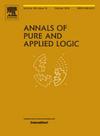The power of the Binary Value Principle
IF 0.6
2区 数学
Q2 LOGIC
引用次数: 0
Abstract
The (extended) Binary Value Principle (, the equation for and Boolean variables ) has received a lot of attention recently, several lower bounds have been proved for it [1], [2], [11]. Also it has been shown [1] that the probabilistically verifiable Ideal Proof System () [8] together with polynomially simulates a similar semialgebraic proof system. In this paper we consider Polynomial Calculus with an algebraic version of Tseitin's extension rule () that introduces a new variable for any polynomial. Contrary to , this is a Cook–Reckhow proof system. We show that in this context still allows to simulate similar semialgebraic systems. We also prove that it allows to simulate the Square Root Rule [6], which is in sharp contrast with the result of [2] that shows an exponential lower bound on the size of derivations of the Binary Value Principle from its square. On the other hand, we demonstrate that probably does not help in proving exponential lower bounds for Boolean formulas: we show that an (even with the Square Root Rule) derivation of any unsatisfiable Boolean formula in CNF from must be of exponential size.
二进制值原理的力量
(扩展的)二元值原理(eBVP,方程∑i=1nxi2i−1= - k对于k>;0和布尔变量xi)最近受到了很多关注,已经证明了它的几个下界[1],[2],[11]。并且证明了概率可验证的理想证明系统(IPS)[8]与eBVP一起多项式地模拟了一个类似的半代数证明系统。本文用tseittin扩展规则(Ext-PC)的代数版本来考虑多项式微积分,该扩展规则为任意多项式引入了一个新变量。与IPS相反,这是一个库克-清算证明系统。我们表明,在这种情况下,eBVP仍然允许模拟类似的半代数系统。我们还证明了它允许模拟平方根规则[6],这与[2]的结果形成鲜明对比,[2]的结果显示了二进制值原理从其平方导出的Ext-PC的大小的指数下界。另一方面,我们证明了eBVP可能对证明布尔公式的指数下界没有帮助:我们证明了从eBVP推导出CNF中任何不满足的布尔公式的Ext-PC(即使使用平方根规则)必须具有指数大小。
本文章由计算机程序翻译,如有差异,请以英文原文为准。
求助全文
约1分钟内获得全文
求助全文
来源期刊
CiteScore
1.40
自引率
12.50%
发文量
78
审稿时长
200 days
期刊介绍:
The journal Annals of Pure and Applied Logic publishes high quality papers in all areas of mathematical logic as well as applications of logic in mathematics, in theoretical computer science and in other related disciplines. All submissions to the journal should be mathematically correct, well written (preferably in English)and contain relevant new results that are of significant interest to a substantial number of logicians. The journal also considers submissions that are somewhat too long to be published by other journals while being too short to form a separate memoir provided that they are of particular outstanding quality and broad interest. In addition, Annals of Pure and Applied Logic occasionally publishes special issues of selected papers from well-chosen conferences in pure and applied logic.

 求助内容:
求助内容: 应助结果提醒方式:
应助结果提醒方式:


